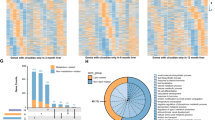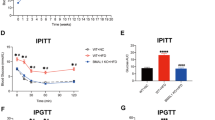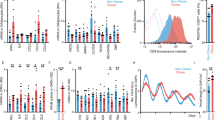Abstract
Objectives:
Physiological and behavioral circadian rhythmicities are exhibited by all mammals and are generated by intracellular levels of circadian oscillators, which are composed of transcriptional/translational feedback loops involving a set of circadian-clock genes, such as Clock, Per1–3, Cry1–2, Bmal1, Dbp, E4BP4 and CK1ɛ. These circadian-clock genes play important roles in regulating circadian rhythms and also energy homeostasis and metabolism. Determining whether obesity induced by high-fat diet affected the expressions of circadian-clock genes and their related genes in peripheral tissues, was the main focus of this study. To address this issue, we fed male C57BL/6 mice a high-fat diet for 11 months to induce obesity, hyperglycemic, hypercholesterolemic and hyperinsulinemic symptoms, and used quantitative real-time reverse transcription-PCR to measure gene expression levels.
Results:
We found that the expressions of circadian-clock genes and circadian clock-controlled genes, including Per1–3, Cry1–2, Bmal1, Dbp, E4BP4, CK1ɛ, PEPCK, PDK4 and NHE3, were altered in the livers and/or kidneys.
Conclusions:
These results indicate that obesity induced by high-fat diet alters the circadian-clock system, and obesity and metabolic syndrome are highly correlated with the expressions of circadian-clock genes and their downstream, circadian clock-controlled genes.
This is a preview of subscription content, access via your institution
Access options
Subscribe to this journal
Receive 12 print issues and online access
$259.00 per year
only $21.58 per issue
Buy this article
- Purchase on Springer Link
- Instant access to full article PDF
Prices may be subject to local taxes which are calculated during checkout







Similar content being viewed by others
References
Anderson LH, Martinson BC, Crain AL, Pronk NP, Whitebird RR, O'Connor PJ et al. Health care charges associated with physical inactivity, overweight, and obesity. Prev Chronic Dis 2005; 2: A09.
Laaksonen DE, Niskanen L, Lakka HM, Lakka TA, Uusitupa M . Epidemiology and treatment of the metabolic syndrome. Ann Med 2004; 36: 332–346.
Association AD . Standards of medical care in diabetes—2006. Diabetes Care 2006; 29 (Suppl 1): S4–S42.
Reaven GM . Role of insulin resistance in the pathophysiology of non-insulin dependent diabetes mellitus. Diabetes Metab Rev 1993; 9 (Suppl 1): 5S–12S.
Reaven GM, Chen YD . Role of insulin in regulation of lipoprotein metabolism in diabetes. Diabetes Metab Rev 1988; 4: 639–652.
Spurlock ME, Gabler NK . The development of porcine models of obesity and the metabolic syndrome. J Nutr 2008; 138: 397–402.
Gekakis N, Staknis D, Nguyen HB, Davis FC, Wilsbacher LD, King DP et al. Role of the CLOCK protein in the mammalian circadian mechanism. Science 1998; 280: 1564–1569.
Dunlap JC . Molecular bases for circadian clocks. Cell 1999; 96: 271–290.
Eide EJ, Kang H, Crapo S, Gallego M, Virshup DM . Casein kinase I in the mammalian circadian clock. Methods Enzymol 2005; 393: 408–418.
Eide EJ, Woolf MF, Kang H, Woolf P, Hurst W, Camacho F et al. Control of mammalian circadian rhythm by CKIepsilon-regulated proteasome-mediated PER2 degradation. Mol Cell Biol 2005; 25: 2795–2807.
Whitmore D, Cermakian N, Crosio C, Foulkes NS, Pando MP, Travnickova Z et al. A clockwork organ. Biol Chem 2000; 381: 793–800.
Preitner N, Damiola F, Lopez-Molina L, Zakany J, Duboule D, Albrecht U et al. The orphan nuclear receptor REV-ERBalpha controls circadian transcription within the positive limb of the mammalian circadian oscillator. Cell 2002; 110: 251–260.
Sato TK, Panda S, Miraglia LJ, Reyes TM, Rudic RD, McNamara P et al. A functional genomics strategy reveals Rora as a component of the mammalian circadian clock. Neuron 2004; 43: 527–537.
Ueda HR, Hayashi S, Chen W, Sano M, Machida M, Shigeyoshi Y et al. System-level identification of transcriptional circuits underlying mammalian circadian clocks. Nat Genet 2005; 37: 187–192.
Lowrey PL, Takahashi JS . Mammalian circadian biology: elucidating genome-wide levels of temporal organization. Annu Rev Genomics Hum Genet 2004; 5: 407–441.
Reppert SM, Weaver DR . Coordination of circadian timing in mammals. Nature 2002; 418: 935–941.
Ripperger JA, Schibler U . Circadian regulation of gene expression in animals. Curr Opin Cell Biol 2001; 13: 357–362.
Shieh KR . Distribution of the rhythm-related genes rPERIOD1, rPERIOD2, and rCLOCK, in the rat brain. Neuroscience 2003; 118: 831–843.
Shieh KR, Yang SC, Lu XY, Akil H, Watson SJ . Diurnal rhythmic expression of the rhythm-related genes, rPeriod1, rPeriod2, and rClock, in the rat brain. J Biomed Sci 2005; 12: 209–217.
Rudic RD, McNamara P, Curtis AM, Boston RC, Panda S, Hogenesch JB et al. BMAL1 and CLOCK, two essential components of the circadian clock, are involved in glucose homeostasis. PLoS Biol 2004; 2: e377.
Turek FW, Joshu C, Kohsaka A, Lin E, Ivanova G, McDearmon E et al. Obesity and metabolic syndrome in circadian Clock mutant mice. Science 2005; 308: 1043–1045.
Zvonic S, Ptitsyn AA, Conrad SA, Scott LK, Floyd ZE, Kilroy G et al. Characterization of peripheral circadian clocks in adipose tissues. Diabetes 2006; 55: 962–970.
Yanagihara H, Ando H, Hayashi Y, Obi Y, Fujimura A . High-fat feeding exerts minimal effects on rhythmic mRNA expression of clock genes in mouse peripheral tissues. Chronobiol Int 2006; 23: 905–914.
Satoh Y, Kawai H, Kudo N, Kawashima Y, Mitsumoto A . Time-restricted feeding entrains daily rhythms of energy metabolism in mice. Am J Physiol Regul Integr Comp Physiol 2006; 290: R1276–R1283.
Bray MS, Young ME . Diurnal variations in myocardial metabolism. Cardiovasc Res 2008; 79: 228–237.
Kohsaka A, Laposky AD, Ramsey KM, Estrada C, Joshu C, Kobayashi Y et al. High-fat diet disrupts behavioral and molecular circadian rhythms in mice. Cell Metab 2007; 6: 414–421.
Rutter J, Reick M, McKnight SL . Metabolism and the control of circadian rhythms. Annu Rev Biochem 2002; 71: 307–331.
Rutter J, Reick M, Wu LC, McKnight SL . Regulation of clock and NPAS2 DNA binding by the redox state of NAD cofactors. Science 2001; 293: 510–514.
Lin JD, Liu C, Li S . Integration of energy metabolism and the mammalian clock. Cell Cycle 2008; 7: 453–457.
Liu C, Li S, Liu T, Borjigin J, Lin JD . Transcriptional coactivator PGC-1alpha integrates the mammalian clock and energy metabolism. Nature 2007; 447: 477–481.
Ando H, Yanagihara H, Hayashi Y, Obi Y, Tsuruoka S, Takamura T et al. Rhythmic messenger ribonucleic acid expression of clock genes and adipocytokines in mouse visceral adipose tissue. Endocrinology 2005; 146: 5631–5636.
Gomez-Abellan P, Hernandez-Morante JJ, Lujan JA, Madrid JA, Garaulet M . Clock genes are implicated in the human metabolic syndrome. Int J Obes (Lond) 2008; 32: 121–128.
Scott EM, Carter AM, Grant PJ . Association between polymorphisms in the Clock gene, obesity and the metabolic syndrome in man. Int J Obes (Lond) 2008; 32: 658–662.
Shimba S, Ishii N, Ohta Y, Ohno T, Watabe Y, Hayashi M et al. Brain and muscle Arnt-like protein-1 (BMAL1), a component of the molecular clock, regulates adipogenesis. Proc Natl Acad Sci USA 2005; 102: 12071–12076.
Bunger MK, Walisser JA, Sullivan R, Manley PA, Moran SM, Kalscheur VL et al. Progressive arthropathy in mice with a targeted disruption of the Mop3/Bmal-1 locus. Genesis 2005; 41: 122–132.
Kondratov RV, Kondratova AA, Gorbacheva VY, Vykhovanets OV, Antoch MP . Early aging and age-related pathologies in mice deficient in BMAL1, the core component of the circadian clock. Genes Dev 2006; 20: 1868–1873.
Hwang LL, Wang CH, Li TL, Chang SD, Lin LC, Chen CP et al. Sex differences in high-fat diet-induced obesity, metabolic alterations and learning and synaptic plasticity deficits in mice. Obesity 2009; In Press. DOI:10.1038/oby.2009.273.
Hofman MA, Swaab DF . Living by the clock: the circadian pacemaker in older people. Ageing Res Rev 2006; 5: 33–51.
Scarbrough K, Losee-Olson S, Wallen EP, Turek FW . Aging and photoperiod affect entrainment and quantitative aspects of locomotor behavior in Syrian hamsters. Am J Physiol 1997; 272: R1219–R1225.
Yamazaki S, Straume M, Tei H, Sakaki Y, Menaker M, Block GD . Effects of aging on central and peripheral mammalian clocks. Proc Natl Acad Sci USA 2002; 99: 10801–10806.
Asai M, Yoshinobu Y, Kaneko S, Mori A, Nikaido T, Moriya T et al. Circadian profile of Per gene mRNA expression in the suprachiasmatic nucleus, paraventricular nucleus, and pineal body of aged rats. J Neurosci Res 2001; 66: 1133–1139.
Claustrat F, Fournier I, Geelen G, Brun J, Corman B, Claustrat B . [Aging and circadian clock gene expression in peripheral tissues in rats]. Pathol Biol (Paris) 2005; 53: 257–260.
Kolker DE, Fukuyama H, Huang DS, Takahashi JS, Horton TH, Turek FW . Aging alters circadian and light-induced expression of clock genes in golden hamsters. J Biol Rhythms 2003; 18: 159–169.
Weinert D . Age-dependent changes of the circadian system. Chronobiol Int 2000; 17: 261–283.
Stavinoha MA, Rayspellicy JW, Hart-Sailors ML, Mersmann HJ, Bray MS, Young ME . Diurnal variations in the responsiveness of cardiac and skeletal muscle to fatty acids. Am J Physiol Endocrinol Metab 2004; 287: E878–E887.
Young ME, Wilson CR, Razeghi P, Guthrie PH, Taegtmeyer H . Alterations of the circadian clock in the heart by streptozotocin-induced diabetes. J Mol Cell Cardiol 2002; 34: 223–231.
De Feo P, Lucidi P . Liver protein synthesis in physiology and in disease states. Curr Opin Clin Nutr Metab Care 2002; 5: 47–50.
Raubenheimer PJ, Nyirenda MJ, Walker BR . A choline-deficient diet exacerbates fatty liver but attenuates insulin resistance and glucose intolerance in mice fed a high-fat diet. Diabetes 2006; 55: 2015–2020.
Rossmeisl M, Rim JS, Koza RA, Kozak LP . Variation in type 2 diabetes-related traits in mouse strains susceptible to diet-induced obesity. Diabetes 2003; 52: 1958–1966.
Cersosimo E, Garlick P, Ferretti J . Renal glucose production during insulin-induced hypoglycemia in humans. Diabetes 1999; 48: 261–266.
Cersosimo E, Garlick P, Ferretti J . Renal substrate metabolism and gluconeogenesis during hypoglycemia in humans. Diabetes 2000; 49: 1186–1193.
Ekberg K, Landau BR, Wajngot A, Chandramouli V, Efendic S, Brunengraber H et al. Contributions by kidney and liver to glucose production in the postabsorptive state and after 60 h of fasting. Diabetes 1999; 48: 292–298.
Meyer C, Dostou JM, Welle SL, Gerich JE . Role of human liver, kidney, and skeletal muscle in postprandial glucose homeostasis. Am J Physiol Endocrinol Metab 2002; 282: E419–E427.
Hall JE . The kidney, hypertension, and obesity. Hypertension 2003; 41: 625–633.
Kramer H . Obesity and chronic kidney disease. Contrib Nephrol 2006; 151: 1–18.
Saifur Rohman M, Emoto N, Nonaka H, Okura R, Nishimura M, Yagita K et al. Circadian clock genes directly regulate expression of the Na(+)/H(+) exchanger NHE3 in the kidney. Kidney Int 2005; 67: 1410–1419.
Nishinaga H, Komatsu R, Doi M, Fustin JM, Yamada H, Okura R et al. Circadian expression of the Na+/H+ exchanger NHE3 in the mouse renal medulla. Biomed Res 2009; 30: 87–93.
Young ME, Razeghi P, Taegtmeyer H . Clock genes in the heart: characterization and attenuation with hypertrophy. Circ Res 2001; 88: 1142–1150.
Acknowledgements
We thank Mr DP Chamberlin for editorial assistance with the paper. This study was supported in part by the National Science Council of Taiwan (NSC95-2320-B-320-006-MY2 to KRS and NSC97-2314-B-277-001-MY3 to SCY), Tzu Chi Foundation (TCIRP95006-01 to KRS) and National Health Research Institutes, Taiwan (NHRI-EX96-9605NI to LLH and NHRI-BP-093-PP-11 to CTC).
Author information
Authors and Affiliations
Corresponding author
Rights and permissions
About this article
Cite this article
Hsieh, MC., Yang, SC., Tseng, HL. et al. Abnormal expressions of circadian-clock and circadian clock-controlled genes in the livers and kidneys of long-term, high-fat-diet-treated mice. Int J Obes 34, 227–239 (2010). https://doi.org/10.1038/ijo.2009.228
Received:
Revised:
Accepted:
Published:
Issue Date:
DOI: https://doi.org/10.1038/ijo.2009.228
Keywords
This article is cited by
-
Non-obesogenic doses of fatty acids modulate the functionality of the circadian clock in the liver
Cellular and Molecular Life Sciences (2019)
-
A circadian rhythm-related MTNR1B genetic variant modulates the effect of weight-loss diets on changes in adiposity and body composition: the POUNDS Lost trial
European Journal of Nutrition (2019)
-
Role of the Circadian Clock in the Metabolic Syndrome and Nonalcoholic Fatty Liver Disease
Digestive Diseases and Sciences (2018)
-
Changes in Gene Expression Patterns of Circadian-Clock, Transient Receptor Potential Vanilloid-1 and Nerve Growth Factor in Inflamed Human Esophagus
Scientific Reports (2015)
-
The nutrigenomic investigation of C57BL/6N mice fed a short-term high-fat diet highlights early changes in clock genes expression
Genes & Nutrition (2013)



